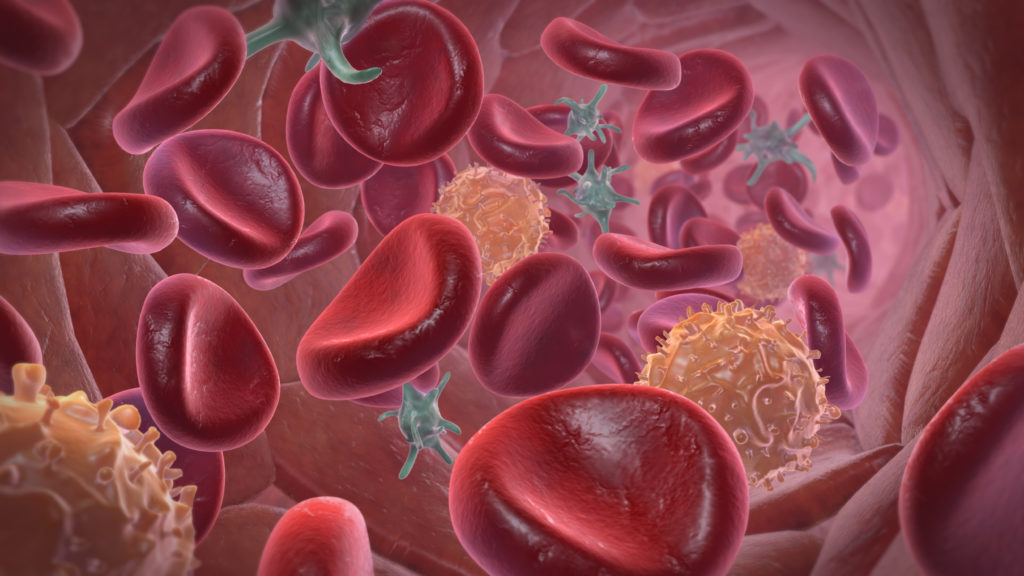Mapping the World of Pediatric Severe Sepsis
Mapping the World of Pediatric Severe Sepsis https://pediatricsnationwide.org/wp-content/uploads/2021/01/AdobeStock_40839791-1024x576.jpg 1024 576 Katie Brind'Amour, PhD, MS, CHES Katie Brind'Amour, PhD, MS, CHES https://pediatricsnationwide.org/wp-content/uploads/2021/03/Katie-B-portrait.gif- April 02, 2018
- Katie Brind'Amour, PhD, MS, CHES

Researchers work to reveal the many subtypes of pediatric sepsis — and what to do about them.
Once upon a time, sepsis was just sepsis. Children experiencing septic shock and its aftermath — any resulting organ failure — were viewed as a fairly homogenous group of patients.
But now, thanks in a large part to the work of teams at Nationwide Children’s Hospital, Cincinnati Children’s Hospital Medical Center, Children’s Hospital of Pittsburgh of University of Pittsburgh Medical Center, and their collaborators, researchers know better: Not all sepsis is created equal.
MULTIPLE AVENUES OF INVESTIGATION
“To the naked eye, children with sepsis look similar at the bedside,” says Mark Hall, MD, chief of the Division of Critical Care Medicine at Nationwide Children’s and a frequent collaborator in multi-institutional pediatric sepsis research. “But there are pathophysiological changes happening in critically ill patients that are not apparent, even through most traditional lab testing.”
Uncovering these unique subtypes of sepsis has been a labor of love for many of the physician-scientists in this field. Each team has an area of emphasis, and each vein of exploration has made significant inroads toward an improved understanding of sepsis pathophysiology and risk stratification.
Collaborative efforts involving Dr. Hall and spearheaded by Hector Wong, MD, director of the Division of Critical Care Medicine at Cincinnati Children’s, for example, have resulted in risk stratification tools known as PERSEVERE and PERSEVERE-XP, which use serum biomarkers and clinical sepsis phenotypes to develop a prognosis. With each subsequent study and the incorporation of more precise prognostic markers, such as tumor protein 53 and mRNA, Dr. Wong and his colleagues near arrival at their destination: a clinically feasible, highly accurate predictor of pediatric sepsis-related mortality risk.
Another approach toward that goal is led by Joseph Carcillo, MD, professor of Critical Care Medicine and Pediatrics at the Children’s Hospital of Pittsburgh, and his collaborators, including Dr. Hall. Their 2017 study in Pediatric Critical Care Medicine proffered a practical risk stratification table to predict pediatric sepsis-related mortality risk using C-reactive protein (CRP) and ferritin blood test results.
“Employing a 2 x 2 table at the bedside using two readily available tests like CRP and ferritin, we can now assess the severity of a patient’s systemic inflammation mortality risk as well as the effectiveness of our therapies in reducing this risk,” says Dr. Carcillo, lead author of the study. Children who reached CRP ≤4.08 mg/dL and ferritin ≤1980 ng/mL, for example, had a low risk for mortality in the study, even if they started with higher levels. Devoting resources to getting patients above those cutoffs down into the low-risk “safe zones” could help physicians track their progress toward an improved prognosis, he says.
GETTING THE LAY OF THE LAND
Together with research partner Jennifer Muszynski, MD, critical care physician and principal investigator in the Center for Clinical and Translational Research at Nationwide Children’s, Dr. Hall has been unravelling the immunobiology of severe sepsis and other critical illness or trauma for nearly 20 years.
“We study the function of white blood cells and the notion of critical illness-induced immune suppression in children, which we call immunoparalysis,” says Dr. Hall. “It’s a state of immune failure that can occur in the setting of many different critical illnesses, including septic shock, and can be measured via a number of laboratory tests.”
To make the identification of patients with immunoparalysis easier, Dr. Hall and his team developed a specialized diagnostic assay. That immunoassay was used in more joint work with Dr. Carcillo, also published in Pediatric Critical Care Medicine in 2017, to identify one of several inflammation-related phenotypes of pediatric severe sepsis and their association with multiple organ failure, macrophage activation syndrome (uncontrolled systemic inflammation known as MAS), and death.
The immunoparalysis phenotype was the most commonly identified phenotype among children with severe sepsis, affecting 24 of 75 children with multiple organ failure and nearly two-thirds of all children with any phenotype used in the study. In general, children with any of the inflammation-related phenotypes were more likely to develop MAS and had a significantly greater risk of death than children with no such phenotype.
Drs. Hall and Muszynski have further explored the phenomenon of immunoparalysis in sepsis cases exclusively at Nationwide Children’s, confirming that the immunoparalysis-associated multiple organ failure phenotype is common and associated with adverse sepsis outcomes. They expect to publish their data in 2018.
ALL ROADS LEAD TO IMPROVED SEPSIS MANAGEMENT
Although these recent studies of children with severe sepsis represent the largest such groups in the pediatric literature, Dr. Hall acknowledges the work is mostly associational. “We have to validate our findings in a multi-center cohort to make sure they’re generalizable,” he says. “And it’s not yet clear that restoring immune function will lead to better outcomes. That has to be tested in clinical trials.”
Sepsis trials in adults have already had some success in applying phenotype-specific therapies to reduce mortality. Clinical trials for immunoparalysis therapies (such as granulocyte macrophage-colony stimulating factor or immunosuppressant tapering) and other sepsis phenotypes have not been initiated yet in children with sepsis, but Dr. Hall expects they are not far off.
“We are going to uncover a whole world of subtypes of critically ill patients identifiable through testing who may respond to individual therapies,” Dr. Hall predicts. “In time, it’s our hope that identifying the distinct pathological sepsis subtypes will translate into better risk stratification, drug discovery and an explosion of treatment regimens that are unique to patients’ individual pathophysiology. We all just have to keep working toward that end goal.”
References:
- Carcillo JA, Halstead ES, Hall MW, Nguyen TC, Reeder R, Aneja R, Shakoory B, Simon D; Eunice Kennedy Shriver National Institute of Child Health and Human Development Collaborative Pediatric Critical Care Research Network Investigators. Three hypothetical inflammation pathobiology phenotypes and pediatric sepsis-induced multiple organ failure outcome. Pediatric Critical Care Medicine. 2017 Jun;18(6):513-523.
- Carcillo JA, Sward K, Halstead ES, Telford R, Jimenez-Bacardi A, Shakoory B, Simon D, Hall M; Eunice Kennedy Shriver National Institute of Child Health and Human Development Collaborative Pediatric Critical Care Research Network Investigators. A systemic inflammation mortality risk assessment contingency table for severe sepsis. Pediatric Critical Care Medicine. 2017 Feb;18(2):143-150.
- Wong HR, Cvijanovich NZ, Anas N, Allen GL, Thomas NJ, Bigham MT, Weiss SL, Fitzgerald JC, Checchia PA, Meyer K, Quasney M, Hall M, Gedeit R, Freishtat RJ, Nowak J, Raj SS, Gertz S, Grunwell JR, Lindsell CJ. Improved risk stratification in pediatric septic shock using both protein and mRNA biomarkers. PERSEVERE-XP. American Journal of Respiratory Critical Care Medicine. 2017 Aug 15;196(4):494-501.
Image credits: Adobe Stock
About the author
Katherine (Katie) Brind’Amour is a freelance medical and health science writer based in Pennsylvania. She has written about nearly every therapeutic area for patients, doctors and the general public. Dr. Brind’Amour specializes in health literacy and patient education. She completed her BS and MS degrees in Biology at Arizona State University and her PhD in Health Services Management and Policy at The Ohio State University. She is a Certified Health Education Specialist and is interested in health promotion via health programs and the communication of medical information.
-
Katie Brind'Amour, PhD, MS, CHEShttps://pediatricsnationwide.org/author/katie-brindamour-phd-ms-ches/April 27, 2014
-
Katie Brind'Amour, PhD, MS, CHEShttps://pediatricsnationwide.org/author/katie-brindamour-phd-ms-ches/April 27, 2014
-
Katie Brind'Amour, PhD, MS, CHEShttps://pediatricsnationwide.org/author/katie-brindamour-phd-ms-ches/April 27, 2014
-
Katie Brind'Amour, PhD, MS, CHEShttps://pediatricsnationwide.org/author/katie-brindamour-phd-ms-ches/April 28, 2014
- Post Tags:
- Critical Care
- Immunology
- Posted In:
- Features






